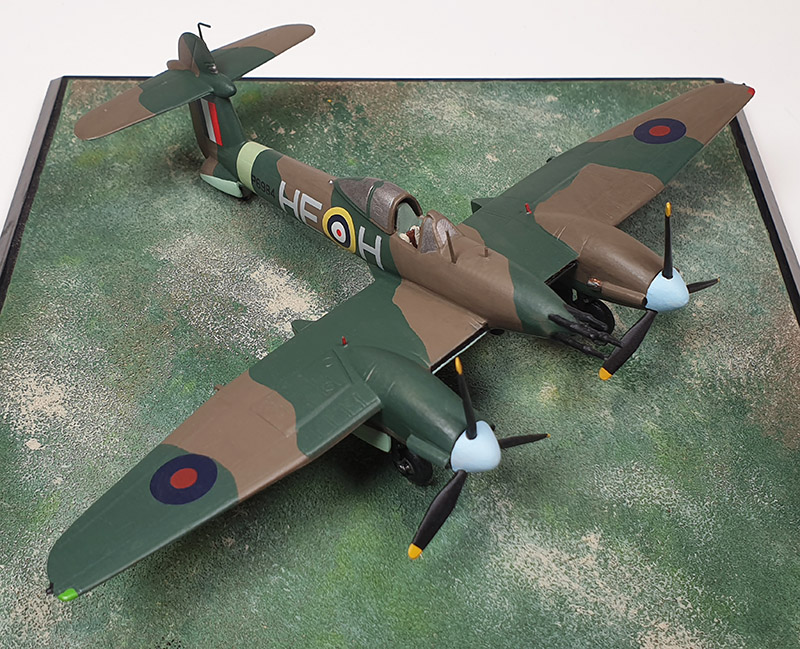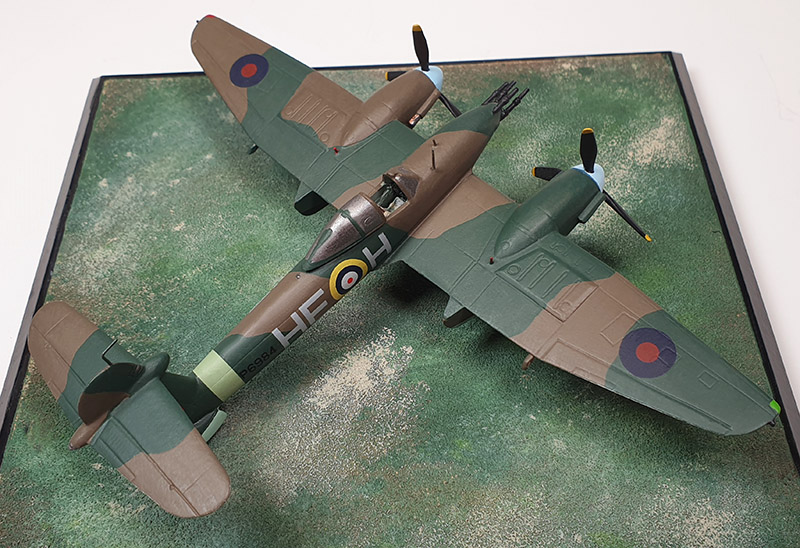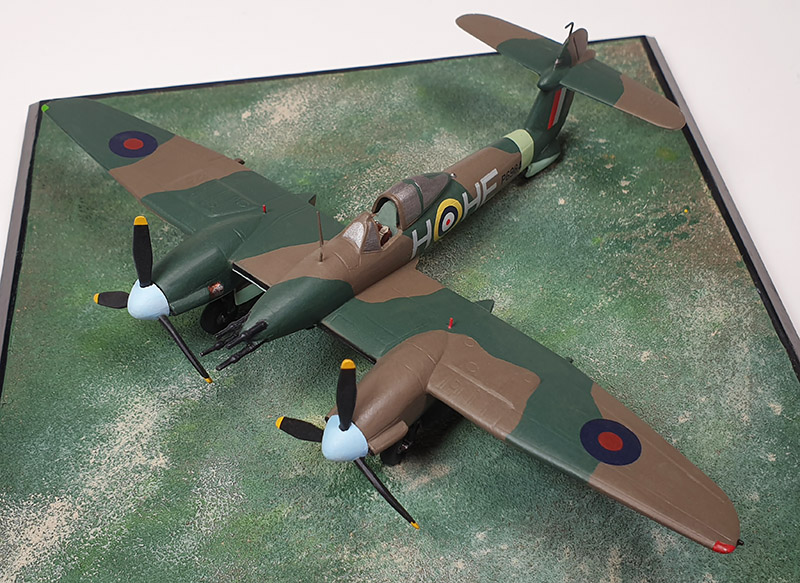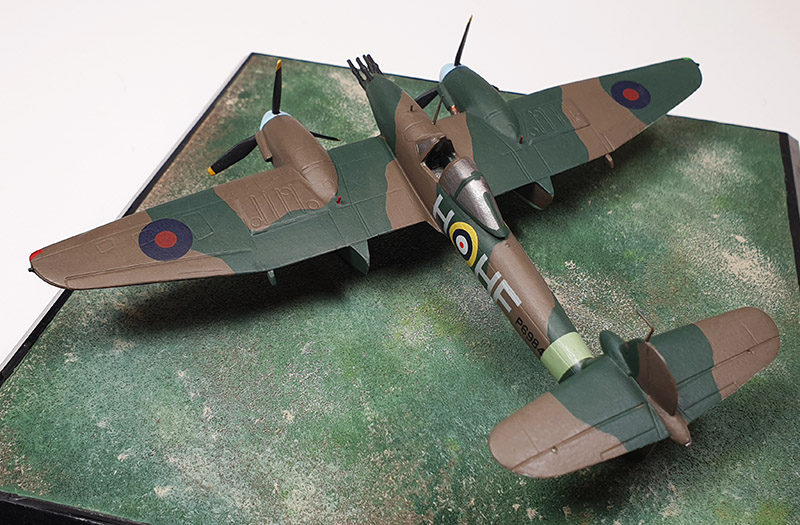Westland Whirlwind Mk I
Westland Whirlwind Mk I, P6984 HE-H
263 Squadron, RAF Exeter, December 1940.
The Westland P.9 Whirlwind was a response to Air Ministry Specification F.37/35 that called for a day and night fighter with four 20 mm cannon and an all-round view for the pilot. The Whirlwind was the only submission selected for construction, and as well as being the RAF’s first cannon-armed fighter it was its first twin-engined fighter to enter service; the selection of Westland, a company with no history of fighter design and production, was something of a surprise, to its competitors in particular, but the Air Ministry considered that with many of the other companies already very busy Westland had capacity in both design and production available. The design under the supervision of W E W Petter was radical in some ways although some of these, such as the routing of the engine exhausts through the nacelles in an effort to minimise drag and leading through ducts in the Fuel tanks, were to course problems in development; similarly its choice of engine Rolls-Royce Peregrine, a developed Kestrel with some Merlin technology, meant that while it was not competing with other types for supply its manufacturer realised when the delivery of production engines was under way that resources for its continuing development would not be available.
The original design had twin fins at the end of a tailplane set on top of the rear fuselage, but wind tunnel tests showed that when the flaps were lowered the tailplane lost its effectiveness; the design was altered to have the tailplane positioned half way a tall single fin, a layout which became a prime recognition feature, and it was in this form that the first prototype made its first from Boscombe Down, at that time a Fairey Battle station – Yeovil was considered too small for early testing – on 11 October 1938, in the hands of Harald Penrose. Testing at RAE Farnborough and at Yeovil showed the need for over 250 modifications, particularly evident being the “bullet ” fairing at the fin/tailplane junction to obviate buffeting, and the first production aircraft P6966, the first of 114, first flew on 22 May 1940. In June this aircraft was delivered, accompanied by P6967, to 25 Squadron at North Weald for trials under operational conditions; at this time 25 was equipped with Blenheim Mk IF night fighters fitted with early airborne RDF (radar), and it was decided that it should continue in this role. Consequently the two Whirlwinds were delivered to Grangemouth to equip 263 Squadron, which had been flying Gladiators in Norway until the end of that campaign.
While delivery of the Westland Whirlwind Mk I continued the aircraft was some way from being operational, and 263 also flew Hurricanes until the end of the year from Drem, while still carrying out intensive flying of the twin while problems, particularly with engines and armament, were resolved. The Hurricanes were withdrawn in November and the squadron took its Whirlwinds down to South-West England, flying initially from Exeter and then from Portreath and St.Eval. Its first ‘score’ was recorded on 12 January 1942 with Plt.Off. Stein claiming a “probable” on a Ju.88 off the Scilly Isles. A principal role at this period was hunting for E-Boats patrolling the English Channel in search of possible survivors from Luftwaffe bombers lost while returning from raids on England, and 263’s first recorded kill was of an Arado 196 floatplane shot down on 8 February by Plt.Off. Traham, who then himself crashed in to the sea. In the summer the squadron’s task became making low-level attacks on German airfields in France, making good use of the Whirlwind’s concentrated heavy armament; the first of these operations was on 14 June 1941 against Querqueville and Maupertus, Bf 109 bases either side of Cherbourg. A second Whirlwind unit, 137 Squadron, was formed at Charmy Down in September 1941, and by 24 October was also carrying out cross-channel missions, with various detachments around the UK. In February the squadron became involved in the running battle over the “Channel Dash” of the German warships Scharnhorst, Gneiseneau and Prinz Eugen, during which it lost four of its aircraft.
In 1941 P6997 had undertaken trials at Boscombe Down carrying a 500 lb bomb under each wing, and in September 1942 this capability was added to both squadrons’ aircraft; sometimes nicknamed “Whirlibombers” their main role was now attacking targets of opportunity across the Channel, the raids being known as Rhubarbs. 137 re-equipped with Hurricane IVs in July 1943, but 263 continued flying the Westland Whirlwind Mk I until the end of the year when they received the Typhoon Mk IB, an aircraft whose ground-attack use with cannon and bombs for which it became celebrated had been presaged by the Whirlwinds’ operations.
Apart from the two prototypes being involved in testing, some of the production aircraft were used for testing and development at Boscombe Down; but all 114 production Whirlwinds saw frontline operational use at some time, though their numbers had dwindled by the end of 1943. Early deliveries wore the dark green/dark earth upper surface camouflage, with half sky/half black undersides; with the changing role, with Ocean Grey replaced the dark earth and the undersurfaces were repainted medium sea grey, this camouflage being better suited for the low flying especially over water.
Scale 1:72 Wingspan 7.5″ (190.5 mm)
Base size 7.71″ (196 mm) square (No. 5)
Weight not including base 10 ozs (286 grams)
Limited edition of 25 only
SOLD OUT





